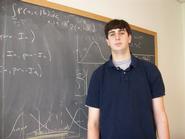
It was love at first sight. At four years old, Will Eagan '11 became entranced by the computer game Math Blaster, which revolved around a mathematical adventure in outer space. For Eagan, math and astronomy are two subjects that continue to captivate him 16 years later.
He is conducting a research project this summer titled "Quantifying the Evolution of Ultra-luminous infrared galaxies (ULIRGs)." ULIRGs are very bright galaxies that emit most of their total energy through infrared waves. Because infrared waves have the longest wavelength of the light on the electromagnetic spectrum, they contain large amounts of dust. Dust accumulation leads to star formation, and thus ULIRGs are vital to cosmologists looking to uncover the universe's vast history. Eagan will be quantifying their evolution this summer with Assistant Professor of Physics Natalia Connolly. As a rising junior at Hamilton, Eagan has taken courses ranging from astronomy to computer programming.
Eagan and Connolly are analyzing a number of different factors that contribute to the evolution of ULIRGs. While they have a model of the evolutionary process, they would like to see it from a mathematical perspective using graph theory. The likelihood ratio – or the ratio of the maximum probability of a result under two different hypotheses – between the high and low infrared spectra will quantify the discrepancy between the two. They will also observe light extinction through parameters such as flux, wavelength and error. Flux is the integral (net area) of an electric or magnetic field passing through a given region.
Through determining the degree of randomness in the diagrams, Eagan will use plots to observe what he calls the "robustness" of spectra clustering in different galaxies. His computer science background should help him as well, because he will need to do large-scale data analysis and help run the C++ program on Hamilton's very own "super computer." He is also comparing the accuracy of two different Monte Carlo Integration techniques: miser and VEGAS. By generating random multivariable polynomials of up to 10 different variables, he will test the accuracy of the two different algorithms (sequences of instructions) for very well-behaved functions.
Besides working with Connolly, Eagan is studying with her husband, Dr. Brian Connolly, a postdoctoral fellow in physics at the University of Pennsylvania and a Scholar-in-Residence at Hamilton. Last summer, Eagan performed research on the application of a similar likelihood ratio to a sampling of Type Ia Supernovae with Andrew Portuguese '11 and the Connollys. He has also presented a poster on Matrix Trigonometry at the MAA Undergraduate Poster Session last January at the Joint Mathematics Meetings in Washington D.C. with Professor of Mathematics Larry Knop.
Eagan is concentrating in math and classics. But these two disciplines are not necessarily at opposite ends of the spectrum. "Classics is a really interdisciplinary major because it incorporates poetry, linguistics, government, art, archaeology – even feminism," he said. In one of his classics classes, Eagan traversed a small but sturdy bridge that linked Roman academia with physics. He wrote a paper on the Roman philosopher Lucretius, whose epic poem titled De Rerum Natura or "On the Nature of the Universe" discussed Epicurian physics. It was essentially a declaration of atomic theory in the form of poetry. Although he found astute and well-intentioned, Isaac Newton ultimately found it hilarious and rejected its lack of determinism.
